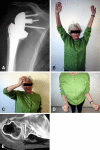Reverse shoulder arthroplasty combined with a modified latissimus dorsi and teres major tendon transfer for shoulder pseudoparalysis associated with dropping arm
- PMID: 18219547
- PMCID: PMC2505202
- DOI: 10.1007/s11999-008-0114-x
Reverse shoulder arthroplasty combined with a modified latissimus dorsi and teres major tendon transfer for shoulder pseudoparalysis associated with dropping arm
Abstract
Although a reverse shoulder arthroplasty (RSA) can restore active elevation in the cuff deficient shoulder, it cannot restore active external rotation when both the infraspinatus and teres minor muscles are absent or atrophied. We hypothesized that a latissimus dorsi and teres major (LD/TM) transfer with a concomitant RSA would restore shoulder function and activities of daily living (ADLs). We prospectively followed 11 consecutive patients (mean age, 70 years) with a combined loss of active elevation and external rotation (shoulder pseudoparalysis and dropping arm) who underwent this procedure. All had severe cuff tear arthropathy (Hamada Stage 3, 4, or 5) and severe atrophy or fatty infiltration of infraspinatus and teres minor on preoperative MRI or CT-scan. The combined procedure was performed through a single deltopectoral approach in the same session. Postoperatively, mean active elevation increased from 70 degrees to 148 degrees (+78 degrees ) and external rotation from -18 degrees to 18 degrees (+36 degrees ). The Constant score, subjective assessment and ADLs improved. The combination of a RSA and LD/TM transfer restored both active elevation and external rotation in this selected subgroup of patients with a cuff deficient shoulder and absent or atrophied infraspinatus and teres minor.
Figures





References
-
- {'text': '', 'ref_index': 1, 'ids': [{'type': 'DOI', 'value': '10.1016/j.jse.2004.04.003', 'is_inner': False, 'url': 'https://doi.org/10.1016/j.jse.2004.04.003'}, {'type': 'PubMed', 'value': '15570230', 'is_inner': True, 'url': 'https://pubmed.ncbi.nlm.nih.gov/15570230/'}]}
- Aldrige JM 3rd, Atkinson TS, Mallon WJ. Combined pectoralis major and latissimus dorsi transfer for massive rotator cuff deficiency. J Shoulder Elbow Surg. 2004;13:621–629. - PubMed
-
- {'text': '', 'ref_index': 1, 'ids': [{'type': 'PubMed', 'value': '8836066', 'is_inner': True, 'url': 'https://pubmed.ncbi.nlm.nih.gov/8836066/'}]}
- Aoki M, Okamura K, Fukushima S, Takahashi T, Ogino T. Transfer of latissimus dorsi for irreparable rotator-cuff tears. J Bone Joint Surg Br. 1996;78:761–766. - PubMed
-
- {'text': '', 'ref_index': 1, 'ids': [{'type': 'DOI', 'value': '10.1097/00006534-198105000-00010', 'is_inner': False, 'url': 'https://doi.org/10.1097/00006534-198105000-00010'}, {'type': 'PubMed', 'value': '7232584', 'is_inner': True, 'url': 'https://pubmed.ncbi.nlm.nih.gov/7232584/'}]}
- Bartlet SP, May JW, Yarenchuk MJ. The latissimus dorsi muscle: a fresh cadaver study of the primary neurovascular pedicle. Plast Reconstr Surg. 1981;67:631–636. - PubMed
-
- {'text': '', 'ref_index': 1, 'ids': [{'type': 'DOI', 'value': '10.1016/S1058-2746(98)90216-6', 'is_inner': False, 'url': 'https://doi.org/10.1016/s1058-2746(98)90216-6'}, {'type': 'PubMed', 'value': '9593084', 'is_inner': True, 'url': 'https://pubmed.ncbi.nlm.nih.gov/9593084/'}]}
- Beauchamps M, Beaton DE, Barnhill TA, Mackay M, Richards RR. Functional outcome after the l’Episcopo procedure. J Shoulder Elbow Surg. 1998;7:90–96. - PubMed
-
- {'text': '', 'ref_index': 1, 'ids': [{'type': 'DOI', 'value': '10.2106/JBJS.E.01097', 'is_inner': False, 'url': 'https://doi.org/10.2106/jbjs.e.01097'}, {'type': 'PubMed', 'value': '17403796', 'is_inner': True, 'url': 'https://pubmed.ncbi.nlm.nih.gov/17403796/'}]}
- Boileau P, Baqué F, Valerio L, Ahrens P, Chuinard C, Trojani C. Isolated arthroscopic biceps tenotomy or tenodesis improve symptoms in patients with massive irreparable rotator cuff tears. J Bone Joint Surg Am. 2007;89:747–757. - PubMed
Publication types
MeSH terms
LinkOut - more resources
Full Text Sources
Other Literature Sources
Medical
Research Materials

